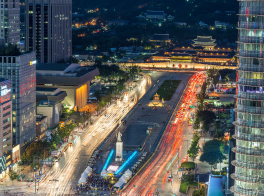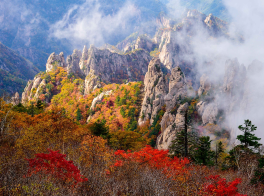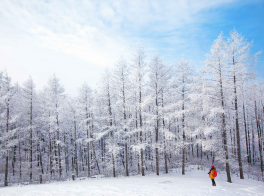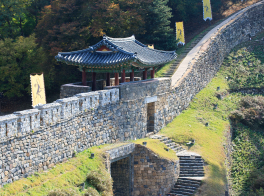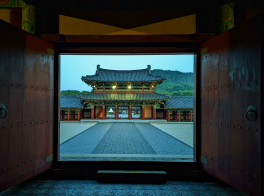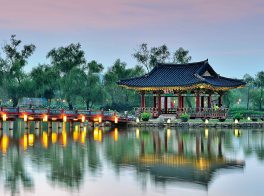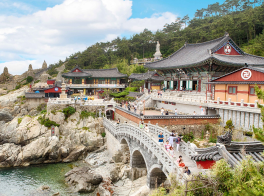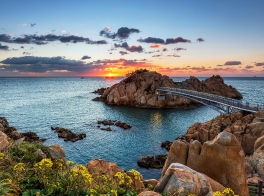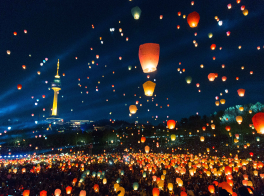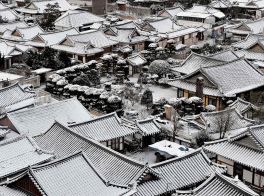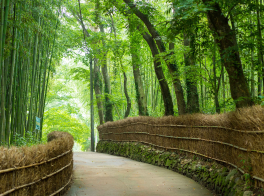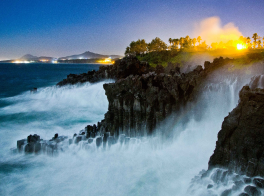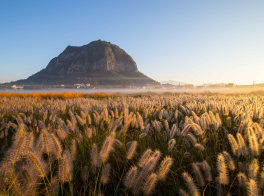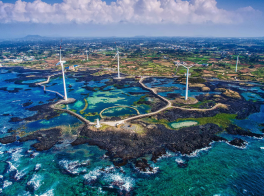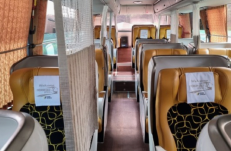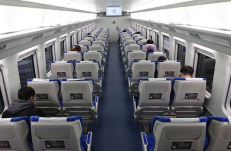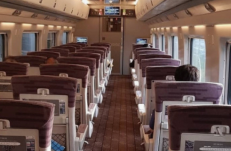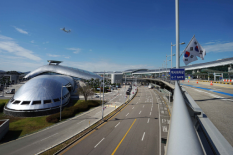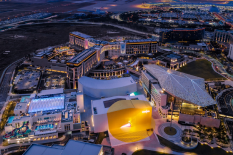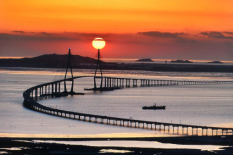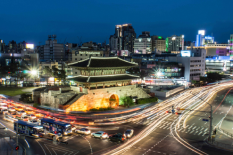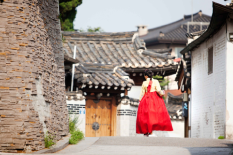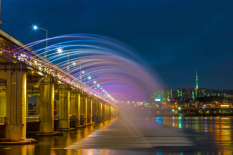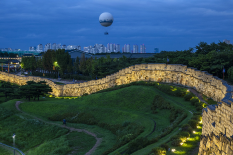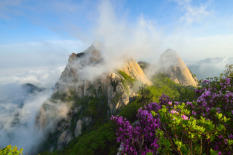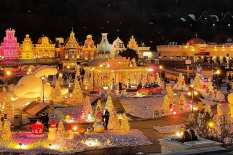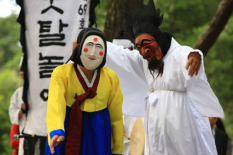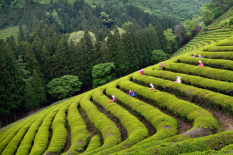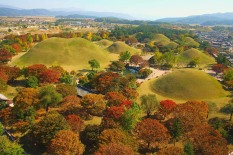Seoul Capital Area
• Includes: Seoul, Incheon, Gyeonggi
Seoul
The heart of modern and traditional Korea. From ancient palaces like Gyeongbokgung to futuristic landmarks like Lotte World Mall, the city offers a unique blend of history, shopping, and vibrant nightlife.
Incheon
Home to the country’s largest international airport.
Gyeonggi-do
Perfect for short day trips, featuring highlights like the DMZ (Demilitarized Zone), Suwon’s UNESCO-listed Hwaseong Fortress, and Everland, a popular theme park.
#Historical, #Cultural, #Cuisine, #City Explorer
Gangwon Region
• Popular Cities: Chuncheon, Pyeongchang, Sokcho, Yangyang, Gangneung• Time from Seoul: 2-3h by bus or train• Tip: It’s a great escape from Seoul for nature lovers and perfect for a 1-2 day trip.
Gangwon-do
Known for its stunning mountains, making it ideal for hiking in Seoraksan National Park or skiing in Pyeongchang. It’s a year-round destination for outdoor adventures.
Beach Area
In the summer, beachgoers can relax along the East Sea coast at beautiful beaches like Sokcho, Gangneung, and Yangyang.
#Historical, #Cultural, #Cuisine, #City Explorer
Chungcheong Region
• Includes: Chungnam, Chungbuk, Daejeon, Saejong• Time from Seoul: 1-2h by KTX or bus
Gongju&Buyeo
These cities are ancient capitals during the Baekje period, filled with UNESCO heritage sites.
Chungnam & Chungbuk
Visitors can enjoy a relaxed rural lifestyle and beautiful nature — Chungnam offers coastal views along the Yellow Sea, while Chungbuk has scenic mountains.
#Historical, #Greenary, #Relaxed
Gyeongsang Region
• Includes: Gyeongnam, Gyeongbuk, Busan, Daegu, Ulsan• Time from Seoul: 2.5h by train, 3.5-4h by bus
Busan
Busan, Korea’s second-largest city, is famous for Haeundae Beach and its beautiful seaside temples.
Gyeonju
Gyeongju was the capital of the Silla Kingdom and is full of cultural relics, such as the Bulguksa Temple and Seokguram Grotto.
Andong
Andong enchants visitors with its traditional village and heritage events, such as the Mask Dance Festivala.
#Cultural, #Coastal, #City Explorer
Jeolla Region
• Includes: Jeonnam, Jeonbuk, Gwangju• Time from Seoul: 2-3h by train or bus.
Jeolla
The Jeolla region is famous for its cuisine, especially Jeonju, known for its UNESCO-listed Hanok Village and delicious traditional dishes like Bibimbap.
Gunsan
Gunsan takes you back in time with its colonial-era architecture, while Damyang features peaceful bamboo forests perfect for scenic nature walks.
Yeosu
Yeosu offers stunning coastal views and lively festivals, and Suncheon is renowned for its lush wetlands and beautiful gardens.
#Cuisine, #Scenic, #Unique, #Historical
Jeju Island
• Time from Seoul: 1h flight
Jeju Island
Jeju Island is Korea’s most famous island destination, known for its volcanic landscapes, including UNESCO-listed Hallasan Mountain, beautiful waterfalls, and stunning beaches. The Jeju Olle Road features scenic coastal trails, ideal for exploring the island’s natural beauty on foot.
#Scenic, #Outdoor Enthusiast, #Coastal
Seoul Capital Area
• Includes: Seoul, Incheon, Gyeonggi
Seoul
The heart of modern and traditional Korea. From ancient palaces like Gyeongbokgung to futuristic landmarks like Lotte World Mall, the city offers a unique blend of history, shopping, and vibrant nightlife.
Incheon
Home to the country’s largest international airport.
Gyeonggi-do
Perfect for short day trips, featuring highlights like the DMZ (Demilitarized Zone), Suwon’s UNESCO-listed Hwaseong Fortress, and Everland, a popular theme park.
#Historical, #Cultural, #Cuisine, #City Explorer
Gangwon Region
• Popular Cities: Chuncheon, Pyeongchang, Sokcho, Yangyang, Gangneung• Time from Seoul: 2-3h by bus or train• Tip: It’s a great escape from Seoul for nature lovers and perfect for a 1-2 day trip.
Gangwon-do
Known for its stunning mountains, making it ideal for hiking in Seoraksan National Park or skiing in Pyeongchang. It’s a year-round destination for outdoor adventures.
Beach Area
In the summer, beachgoers can relax along the East Sea coast at beautiful beaches like Sokcho, Gangneung, and Yangyang.
#Historical, #Cultural, #Cuisine, #City Explorer
Chungcheong Region
• Includes: Chungnam, Chungbuk, Daejeon, Saejong• Time from Seoul: 1-2h by KTX or bus
Gongju&Buyeo
These cities are ancient capitals during the Baekje period, filled with UNESCO heritage sites.
Chungnam & Chungbuk
Visitors can enjoy a relaxed rural lifestyle and beautiful nature — Chungnam offers coastal views along the Yellow Sea, while Chungbuk has scenic mountains.
#Historical, #Greenary, #Relaxed
Gyeongsang Region
• Includes: Gyeongnam, Gyeongbuk, Busan, Daegu, Ulsan• Time from Seoul: 2.5h by train, 3.5-4h by bus
Busan
Busan, Korea’s second-largest city, is famous for Haeundae Beach and its beautiful seaside temples.
Gyeonju
Gyeongju was the capital of the Silla Kingdom and is full of cultural relics, such as the Bulguksa Temple and Seokguram Grotto.
Andong
Andong enchants visitors with its traditional village and heritage events, such as the Mask Dance Festivala.
#Cultural, #Coastal, #City Explorer
Jeolla Region
• Includes: Jeonnam, Jeonbuk, Gwangju• Time from Seoul: 2-3h by train or bus.
Jeolla
The Jeolla region is famous for its cuisine, especially Jeonju, known for its UNESCO-listed Hanok Village and delicious traditional dishes like Bibimbap.
Gunsan
Gunsan takes you back in time with its colonial-era architecture, while Damyang features peaceful bamboo forests perfect for scenic nature walks.
Yeosu
Yeosu offers stunning coastal views and lively festivals, and Suncheon is renowned for its lush wetlands and beautiful gardens.
#Cuisine, #Scenic, #Unique, #Historical
Jeju Island
• Time from Seoul: 1h flight
Jeju Island
Jeju Island is Korea’s most famous island destination, known for its volcanic landscapes, including UNESCO-listed Hallasan Mountain, beautiful waterfalls, and stunning beaches. The Jeju Olle Road features scenic coastal trails, ideal for exploring the island’s natural beauty on foot.
#Scenic, #Outdoor Enthusiast, #Coastal


